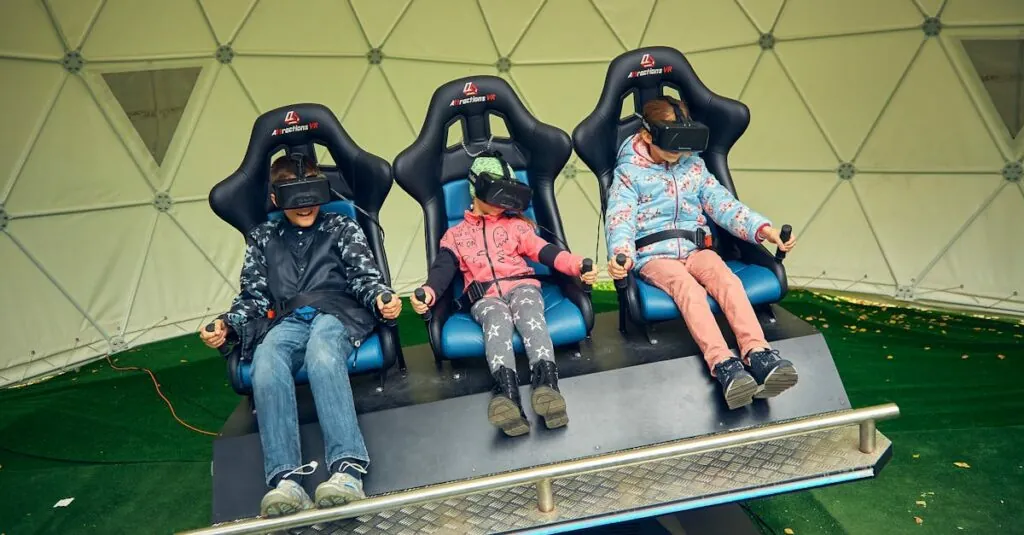Imagine a world where kids can leap into their favorite video games or explore the depths of the ocean without ever leaving their living room. Virtual reality for kids isn’t just a futuristic dream; it’s a reality that’s transforming playtime into an adventure of epic proportions. With VR headsets becoming more accessible, children can now embark on journeys that spark creativity and ignite their imaginations.
Table of Contents
ToggleOverview of Virtual Reality
Virtual reality introduces a digital environment for children, creating engaging experiences that enhance learning and play. With VR, kids can step into worlds that spark their imagination and encourage exploration. This technology immerses users in a 360-degree space, allowing them to interact with virtual elements as if they were real.
Many VR products cater specifically to younger audiences. Popular platforms include Oculus Quest and PlayStation VR, which offer a range of kid-friendly games and educational experiences. Research indicates that VR can improve cognitive skills and spatial awareness in children, making it a valuable educational tool.
Safety measures in VR ensure children engage with the technology responsibly. Features like time limits help prevent excessive use, promoting balance in play and screen time. In addition, age-appropriate content is crucial. Developers often label games clearly, guiding parents in selecting suitable experiences for their children.
Furthermore, VR can facilitate social interactions among peers. Multiplayer games encourage teamwork and communication, enabling kids to connect while playing remotely. This capability supports social skills development, which is essential in today’s digital landscape.
To sum up, the potential of virtual reality for kids extends beyond entertainment. Educational benefits, social interaction opportunities, and an immersive experience create a versatile platform for learning and creativity. As technology continues to evolve, it becomes increasingly important to explore how VR can contribute positively to children’s growth and development.
Benefits of Virtual Reality for Kids
Virtual reality offers numerous advantages for children, transforming entertainment into incredible learning opportunities. Beyond mere play, VR supports cognitive development and enhances creativity.
Enhancing Learning Experiences
Engaging with virtual reality encourages interactive learning. Children can take virtual field trips to historical sites and dive into the ocean, experiencing lessons firsthand. Research indicates that immersive environments lead to better retention of information. Subjects like science and mathematics become more tangible through simulations. VR platforms enable kids to explore complex concepts in a visually appealing way, making abstract ideas concrete. Personalized learning paths cater to individual needs, fostering a love for education.
Improving Social Skills
Virtual reality promotes social interactions among peers. Through multiplayer games, children collaborate to achieve common goals, enhancing teamwork. Engaging in VR worlds helps them practice communication skills in a low-pressure setting. Positive social experiences build confidence and encourage relationships beyond virtual spaces. These interactions facilitate empathy as kids work together to solve challenges. Real-time feedback during gameplay allows for seamless learning of social cues and norms. Overall, VR becomes a valuable tool for social development, bridging gaps between digital and real-life interactions.
Risks and Challenges
Virtual reality poses several risks and challenges for children. Understanding these factors ensures safe and responsible use of this emerging technology.
Potential Health Concerns
VR experiences can lead to discomfort and health issues. Eye strain occurs due to prolonged exposure to screens. Motion sickness might also arise, resulting in dizziness or nausea while navigating virtual environments. Children may experience headaches after extended sessions. Young users typically have developing visual and cognitive systems, making them more sensitive to these effects. Maintaining appropriate breaks and monitoring usage durations helps mitigate these risks. Parents and guardians should stay attentive to any signs of discomfort and adjust usage accordingly.
Age Appropriateness
Choosing VR content suitable for a child’s age is crucial. Platforms often categorize games and experiences by age ratings, which helps guide selections. Younger children may struggle with complex gameplay or intense content, which can lead to confusion or anxiety. Content designed for older children might include themes or mechanics beyond younger users’ comprehension. Parents should review the game’s themes, gameplay mechanics, and intended audience before allowing access. Furthermore, guidelines from health organizations and developers provide additional insights into age-appropriate content, supporting informed decision-making.
Popular Virtual Reality Platforms for Kids
Several virtual reality platforms cater to the needs of children, offering immersive experiences and educational opportunities.
Oculus Quest for Family Use
Oculus Quest stands out as a versatile option for families. Parents appreciate its standalone design, eliminating the need for external devices. The library includes numerous kid-friendly games, ensuring engaging experiences for younger users. Features like parental controls allow mom and dad to monitor usage and set time limits easily. Kids enjoy creative titles that spark imagination while promoting problem-solving skills. Accessibility remains a key attribute, as the wireless setup enables unrestricted movement during play. Oculus Quest enables social interaction through multiplayer options, nurturing collaboration and communication among players.
PlayStation VR for Younger Gamers
PlayStation VR presents a captivating choice for younger gamers. It boasts an extensive selection of titles designed specifically for children, offering safe and enjoyable gameplay. Parents value the strong safety features that protect young users from inappropriate content. The headset integrates well with existing PlayStation consoles, providing a familiar gaming environment. Fun educational experiences allow kids to engage with subjects like history and science through immersive simulations. Social features encourage teamwork in multiplayer settings, reinforcing the importance of cooperation. PlayStation VR designs experiences that ignite curiosity and support balanced, healthy play habits.
Best Virtual Reality Games for Kids
Several engaging virtual reality games capture children’s imaginations while providing educational benefits. One popular choice is Beat Saber, which combines music and rhythm with movement, improving hand-eye coordination.
Another favorite, Astro Bot Rescue Mission, delights kids with its vibrant world and interactive gameplay, effectively enhancing spatial awareness and problem-solving skills.
For those interested in exploration, Ocean Rift offers a unique underwater experience, allowing children to safely observe marine life while learning about ecosystems.
Job Simulator serves up fun in a humorous take on everyday careers, giving kids a taste of various professions while developing critical thinking abilities.
In the realm of education, Tilt Brush stands out by encouraging creativity through virtual painting, allowing children to express themselves in unique ways.
Minecraft VR engages young players in building and crafting, promoting teamwork and collaboration through multiplayer modes.
VR platforms like Oculus Quest provide a wide array of kid-friendly titles, ensuring age-appropriate content is available for young users.
Similarly, PlayStation VR boasts a rich library of games that cater to younger audiences, emphasizing safety features and educational experiences.
These games not only entertain but also foster learning and social interaction, making them excellent choices for parents seeking enriching virtual experiences.
Virtual reality is reshaping how children learn and play. By immersing them in interactive environments, VR not only enhances their creativity but also fosters essential cognitive skills. As kids engage with educational content through platforms like Oculus Quest and PlayStation VR, they’re not just having fun; they’re building a foundation for lifelong learning.
While the benefits are substantial, it’s crucial for parents to prioritize safety and monitor usage. With the right precautions in place, VR can be a powerful tool for growth and development. As this technology continues to advance, its role in children’s education and social interaction is likely to expand, making it an exciting frontier for young explorers.








